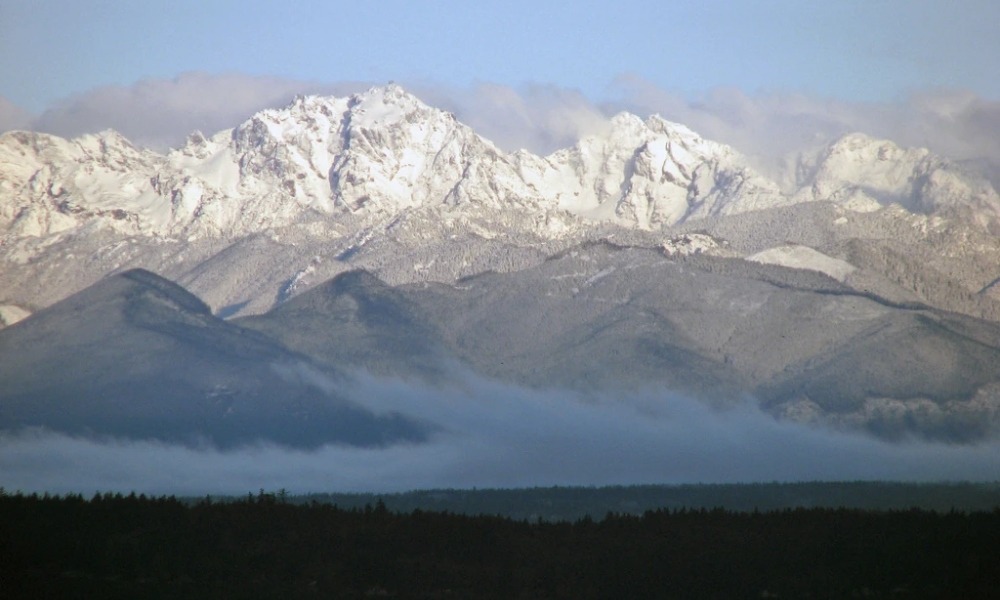In 1885 and 1890, a 22-year-old New York U.S. Army lieutenant named Joseph Patrick O’Neil led expeditions into the Olympic Peninsula that unlocked mysteries and provided valuable information.
Capped by snowfields and glaciers, the Olympic Mountains are 60 miles across and cover one-half of America’s continental northwest corner. The region’s highest peak, now called Olympus, was originally sighted and named Santa Rosalia by Spanish explorer Juan Perez. In July of 1885, while stationed at Fort Vancouver, Lt. O’Neil received orders to “proceed to the section of the country lying west of Puget Sound to conduct a reconnaissance into the Olympic range of mountains.” O’Neil had previously been posted to Port Townsend, within sight of the snowy Olympics, where he had contemplated their remoteness and beauty. Now the young University of Notre Dame graduate would be challenged to touch the girth of Mt. Santa Rosalia-Olympus.
On July 17, 1885, Lt. O’Neil’s party of six men and eight mules left Port Angeles and trudged up the Elwha River. The density of timber and steep hills slowed progress on some days to a quarter of a mile. Upon scaling the Sister Peaks the men had their first breath-taking view of the Strait of Juan de Fuca. While chasing a herd of elk, expedition members suddenly scampered out of the forest shouting that a bear had thwarted their progress. While firing errant shots at the startled bear, the elk were spooked. Eventually, a doe was brought down, enabling the group to substitute elk steak for the monotony of government rations.
To the surprise of O’Neil’s party, they came across evidence of hunters on these remote northern slopes. A dilapidated log cabin was discovered. Members of the party returned to Port Angeles while others explored and mapped trails. During one of those forays a member of the party, Private John Johnson, the cook, wandered off. While searching for Johnson, and over a month into their exploration, Lt. O’Neil was given orders to report to Fort Leavenworth, Kansas. The following November, from his Kansas post, O’Neil sent a copy of his Olympics report with maps. He also enclosed a request to return one day and continue explorations.
On November 11, 1889, Washington was admitted to the Union as the 42nd state. This belated event and completion of the transcontinental railroad spurred new interest in Puget Sound country. Lt. O’Neil, now 27 years old, pressed his superiors to resume probing the Olympics. His tenacity was rewarded in July of 1890 when he led a party of four scientists and 10 enlisted men on an expedition to cut a trail across the Olympic Mountains from Hood Canal to the Pacific Ocean.
Lt. O’Neil mapped mountains, collected topographic, geologic, and botanic details, and went about his work in a systematic, organized manner. For example, when cutting a mule trail aimed at the center of the Olympics, O’Neil sent scouts ahead to find the best route. Once a base camp was established, he dispatched parties in several directions. His men sketched the country, traced the courses of rivers, took photographs, climbed peaks, and named topographical features. Diaries were kept and reports written.
The mule trains carried from 100 to 200 pounds each, pushing into virgin country extended from Hood Canal to Grays Harbor, with spurs to Lakes Cushman and Quinault. Only a few years later, however, his southern route — once known as the “O’Neil Trail” — was obliterated. His main route exists today as part of the federal trail system.

According to writer Robert L. Wood in his book Men, Mules and Mountains, Joseph O’Neil was a “natural leader.” Wood asserts that O’Neil maintained control but was fair and reasonable in his expectations. He pitched in to do the same work as his men, but occasionally displayed a “short fuse” or temper, which Wood attributes to O’Neil’s “Irish roots.”
Lt. O’Neil apparently practiced a kind of rudimentary conservation when our country’s resources were being plundered and abused. For example, he advocated protection for the Olympic elk and insisted that his men only kill game to be consumed.
O’Neil left the Pacific Northwest in 1891, served in Montana, Cuba, Oregon, Nebraska, Texas, and Arkansas. He was appointed brigadier general in 1918 and sailed for Europe with the American Expeditionary Forces in the Great War. At the end of his career and after returning from Europe and being honorably discharged, he died in Portland, Oregon on July 17,1938.
Lt. Joseph Patrick O’Neil saw everything and went everywhere, but his youthful explorations of the Olympic Peninsula, often called America’s “last wilderness,” stand out as the masterwork of his life.
Discover more from Post Alley
Subscribe to get the latest posts sent to your email.

Thank you for this article, Junius. I forwarded it to my brother -in-law who lives on the Olympic Peninsula and knows its woods well. He’s now looking forward to reading Men, Mules and Mountains. He has a correction for you: a female elk is called a cow, rather than a doe. Thanks!
Another wonderful history tale never taught in my history classes.
Thank you for writing Lt. O’Neil’s story.